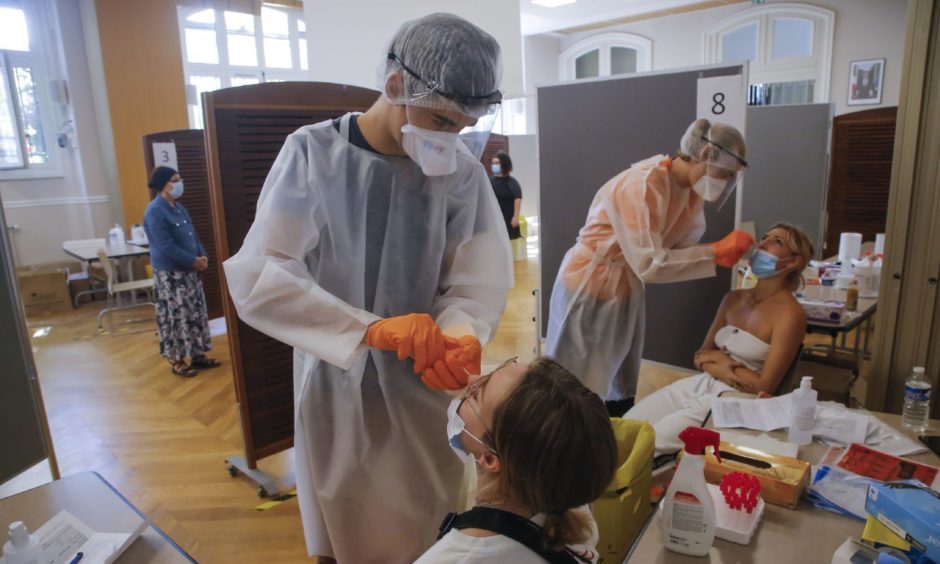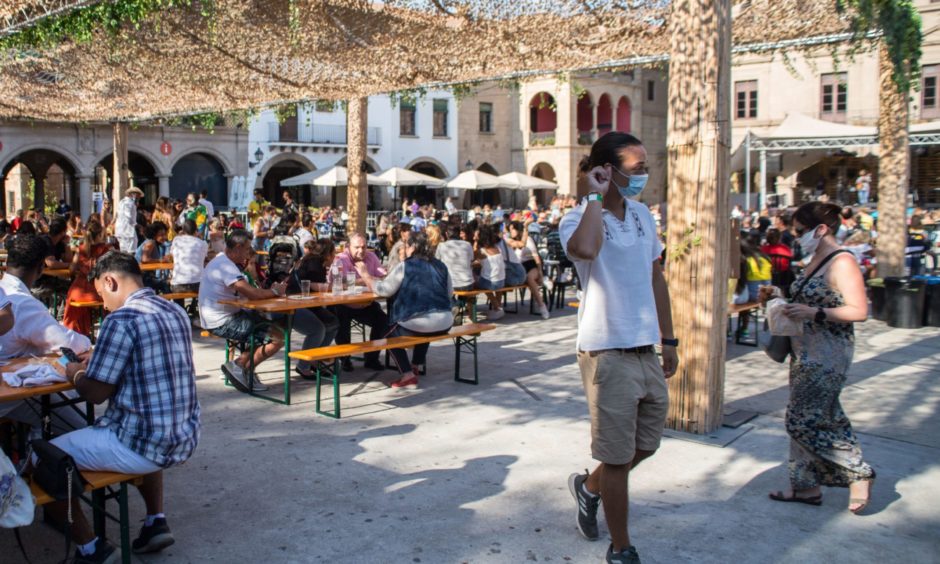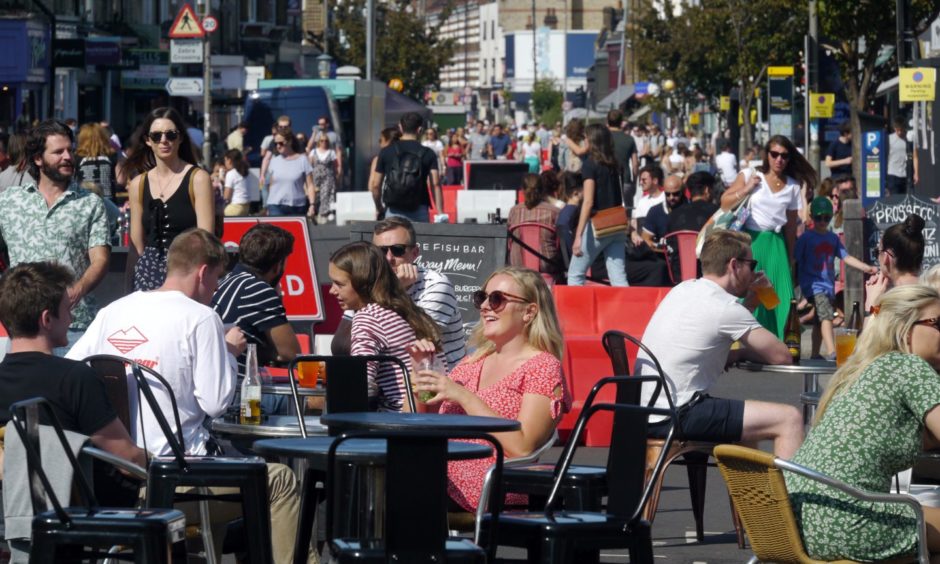Several large European nations have seen a steady increase in the number of coronavirus infections being recorded in recent weeks.
While the death toll and hospitalisation rates have not yet risen at the same rate, fears are growing of a second surge of the virus across the world, with countries working to introduce new restrictions in a bid to stem the spread before it hits the most vulnerable.
Further afield, Israel has recently announced it will reinstate a strict nationwide lockdown amid a surge in coronavirus cases.
On May 12, the World Health Organisation (WHO) advised governments that before reopening, rates of positivity in testing should remain at 5% or lower for at least 14 days.
The positivity rate is useful for measuring the extent of the pandemic as it indicates the level of testing relative to the size of the outbreak.
Countries including France and Spain have seen the number of positive cases rise above this figure, with Scotland also edging closer to 3%.
The First Minister has warned of the risks of being complacent over the increase in cases, particularly among younger people.
Speaking earlier this month, she said: “We can see from the level of cases in countries like Spain and France that the current increase in cases could very easily continue and could start to translate into serious illness and death, if we are not very careful.”
France
France has been grappling with a resurgence in coronavirus cases in recent weeks.
A total of 10,561 new Covid-19 infections were recorded on Saturday – the first time they have topped 10,000 over 24 hours in France since the pandemic began.
This dropped to 7,183 cases on Sunday, with a seven-day average of 8,045.
Infection rates have risen for all age groups since June, but officials say the increase is particularly significant among young adults, a trend which has been replicated across other countries in Europe, including Scotland.
While ICU figures are just a fraction of what they were at the height of the pandemic in April, when the number of patients in intensive care totalled over 7,000, the number has steadily increased since mid-August.
The number of deaths recorded in the country’s hospitals and nursing homes rose by 80 on Friday, the most since mid-July, and by 17 over 24 hours on Saturday.
Officials have designated 42 regions as “red zones”, where the virus is actively circulating and where stricter mask requirements and gathering restrictions are in force.
This includes Paris, Lyon and almost the entire Mediterranean coastline.
On May 12, the World Health Organisation (WHO) advised governments that before reopening positive rates in testing should remain at 5% or lower for at least 14 days.
This measurement crept back above 5% in France earlier this month.
Speaking on Friday, Prime Minister Jean Castex said the country is experiencing a “clear worsening” of the spread of Covid-19, which has “not lowered in intensity” and “will still be with us for some months”.
Although he did not announce any major new restrictions, he said his government would fast-track Covid-19 testing for priority cases and provide local authorities with the power to make some businesses reduce opening hours.
Spain
Spain is experiencing a surge in coronavirus cases, worse than its European neighbours, suffering more than 12,000 infections in a single day on Friday.
A total of 11% of the country’s residents tested for coronavirus have positive results – far above the level in France, Italy and the UK.
Spain’s leaders have directed criticism at young people for spreading the virus through partying and socialising, with the average age of coronavirus cases dropping from 59 at the end of March to 38 this month.
The country was placed under one of the strictest lockdowns during the peak of the pandemic but the virus has spread rapidly since these restrictions were rapidly dropped in June.
The most hard-hit regions of Spain – including Madrid and Catalonia – have recently limited social gatherings to 10 people while Murcia limits them to just six.
At present, only around 5% of cases nationwide lead to hospitalisation, with 0.4% of people losing their lives to the virus.
In Madrid, Covid-19 patients occupy 17% of all hospital beds with fears mounting that the younger people currently being infected could spread the virus to their more vulnerable elderly relatives.
However, the death toll has not risen at the same rate as the surge in new cases, with 241 recorded in the seven days up to Friday.
Italy
While once the epicentre of the Covid-19 pandemic, Italy has managed to keep new coronavirus infections much lower than some of its European counterparts, including France, Spain and the UK.
New coronavirus cases have reached more than 1,000 each day for most of September, with a total of 1,456 cases recorded on Sunday, far below the peak of the virus in March when there were more than 6,000 in 24 hours.
Positive testing rates also remain relatively low, hovering around 2.5%, but has been rising slowly since mid-August.
However, in July less than 1% of those tested received a positive result for coronavirus.
Although both hospitalisation rates and ICU admissions remain far lower than during the peak of the virus, there are signs these have both steadily begun to increase since the middle of August and in line with an increase in cases.
According to the latest seven day average, around 10 deaths have been recorded each day.
Millions of children in Italy returned to school on Monday, more than six months after they were closed due to the coronavirus pandemic.
United Kingdom
New rules were introduced across the UK on Monday, as figures show more than 3,000 coronavirus cases were recorded overall each day up to Sunday.
This dropped to 2,621 confirmed cases on Monday, a fall after three consecutive days with more than 3,000 positive tests.
Measures making it illegal to socialise in groups of more than six came into force at midnight on Sunday across Britain – with Scotland going one step further by limiting this to six people from two households.
It follows a rise in the spread of the virus in recent weeks with local lockdowns imposed in areas across the UK, including in Aberdeen.
A government-commissioned study from Imperial College London published on Friday showed that the number of infections was doubling every week.
However, new reported deaths remain comparatively low, compared to the peak of the virus in April with a seven-day average of 11 daily deaths.
Peter Openshaw, a professor of experimental medicine at Imperial College London, warned on Sunday that Britain may be only a few days from losing control of coronavirus infections.
He said: “We really need to act very quickly now in order to prevent this from growing exponentially.”
The positive testing rate across the UK has remained relatively stable at around 1.3%.
Scotland
Scotland has also seen the number of positive cases rise in recent weeks, with daily cases reaching more than 200 on Saturday and Sunday, before dropping to 70 on Monday.
Crucially, the positive test rate also appears to be increasing, reaching 3.74% on Sunday, the highest proportion of individuals testing positive since the end of May.
The seven-day average puts the rate of people testing positive for the virus at under 3% but the figure is inching closer to the all-important 5%.
Deaths remain low with the last deaths recorded on September 8 when there were three.
Israel
Israel is understood to be the first country in the world to reinstate a strict nationwide lockdown amid a surge in coronavirus cases.
Prime Minister Benjamin Netanyahu made the announcement in a televised speech on Sunday.
Beginning on Friday, the eve of the Jewish New Year, schools, restaurants, shopping centres and hotels will shut down and restrictions on movement will be imposed.
The lockdown will remain in place for at least three weeks, at which point officials are expected to relax measures if numbers are seen to be declining.
The country is recording more than 4,000 daily cases of the virus, after being criticised for opening businesses and schools too quickly.
The country hit a record high of 519 patients in a serious condition, of which 144 were intubated.
The positive test rate has been above 5% since the middle of July.





